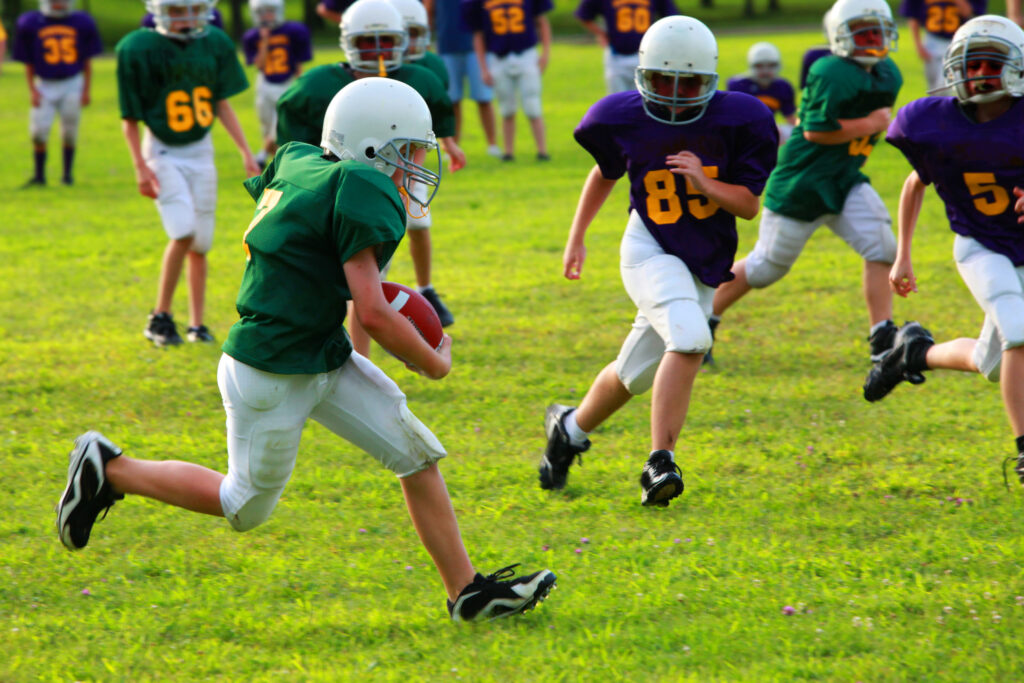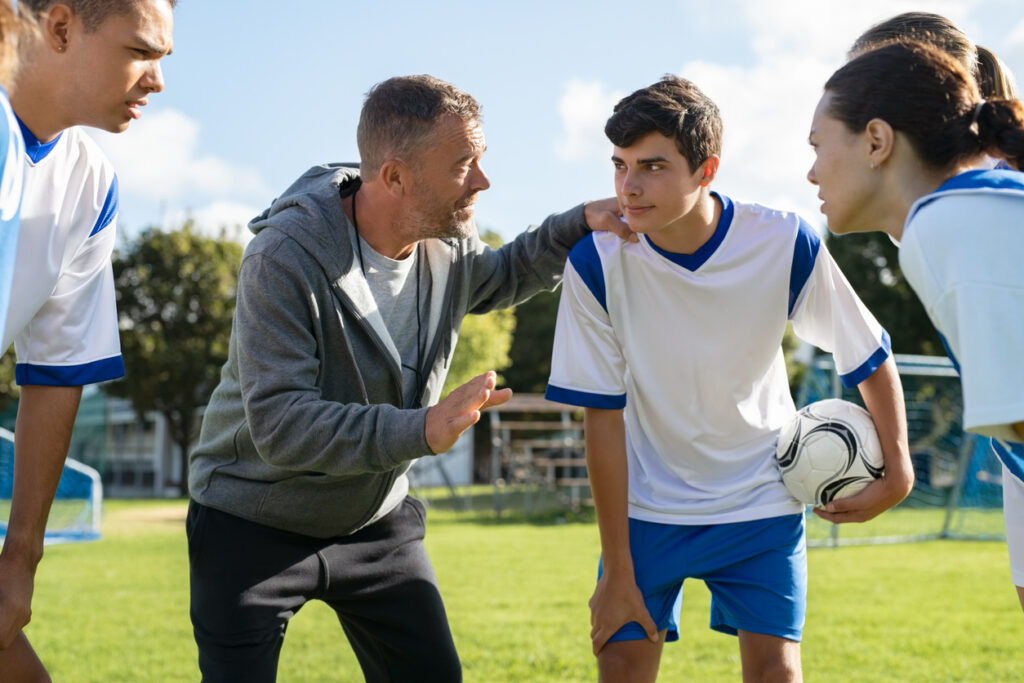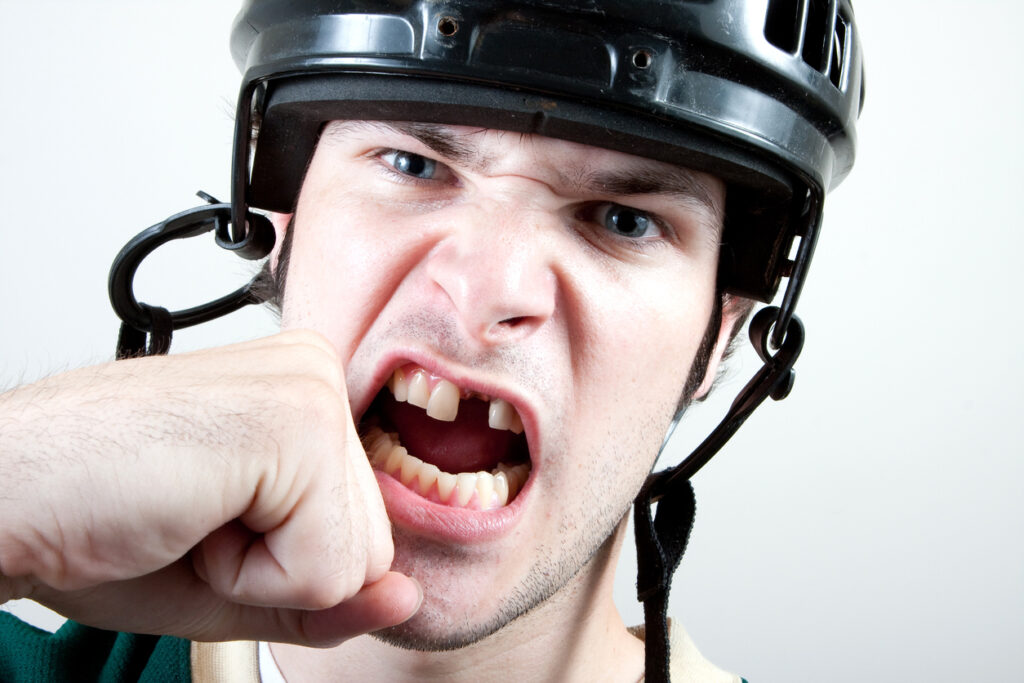If you’ve ever watched a youth sports game, you’ll inevitably see some athletes playing more aggressively than others. Certain teens will push, roughhouse, and be overly hostile to their opponents, even going above and beyond the instrumental aggression necessary to win.
Two Types of Aggression

Researchers identify two types of aggression related to sports: instrumental aggression and hostile aggression.
What is instrumental aggression?
By nature, certain sports (such as football, ice hockey, etc.) have higher levels of contact between players. Thus, they inevitably include more aggression. But such violence is often within the bounds of the game. You often need to play with a certain measure of physical aggressiveness in order to win. That’s instrumental aggression.
Hostile aggression, on the other hand, is violence that goes beyond the scope of the sport. Being hostile refers to “impulsive, angry aggression intended to hurt someone who has in some way provoked an individual” (Russell, 2008). One famous example of hostile aggression in sport is a 2006 World Cup football (soccer here in the U.S.) match. After being insulted by Italian athlete Marco Materazzi in the middle of the game, French player Zinedine Zidane delivered a serious headbutt to his chest, which sent him flying to the ground. Such action was in no way necessary to the game itself; it was simply a way to retaliate against the athlete. Zidane wanted to hurt his provoker as badly as possible.
Hostile Aggression Among Teen Athletes
In discussing the problem of aggression, most experts are talking about the concept of hostile – not instrumental – aggression.
In surveying 800 adolescent athletes playing 10 different sports all across the U.S., Shields (2005) found that 13% of students have tried to deliberately hurt an opponent at least once during a game. Seventeen percent have said something mean to an opponent. And almost 40% have tried to “get back” at another player.
The question is why.
Why do some teens manage to play fair, while others play with hostile aggression?
Some Theories
Heroes Modeling Bad Behavior
Increased media attention on pro-athletes has revealed shocking displays of violence both on and off the sports field. This has an influence on young fans, who often admire and glamorize such athletes. One researcher (Smith, 1983) asked adolescent hockey players who their favorite National Hockey League (NHL) player was. He found that there was a positive correlation between skaters whose NHL hero was aggressive and the young athlete’s own play.
Aggressive Parents
But aggressive behavior isn’t only seen on TV. Often, it’s closer to home. Certain parents could be violent and aggressive with their children at home, as well as on the sports field. (One Minnesota survey found that 17% of adolescent athletes said that an adult had hit, kicked, and slapped them while participating in sports.) Experiencing such violent behavior has a mimicking effect, says researchers. See the case of Thomas Junta and Michael Costin in 2000, and what happened to their kids thereafter.
Showing Loyalty or Seeking Revenge
Moral reasoning theory suggests that some teens think aggressive behavior is not just okay, but even the right thing to do in certain circumstances. “Aggressive behavior is often…justified by players to demonstrate loyalty to teammates, and especially injured teammates, by seeking revenge particularly in competitive, body-checking leagues,” says Cusimano (2016). Hurtful insults, mean taunts, and even stares can provoke certain players, who will then retaliate by become more aggressive (Gordon Russell, 2008). Sports psychologists note that not all athletes respond to the same provocation in the same way. Personality differences, temperament, and even regional hometown (!) change the way athletes will respond to a hurtful remark. For example, Type-A teens will be more likely to get angry when they’re insulted.
Getting Too Hot
Sounds crazy, but it really is true: environmental factors like heat leads to aggression. Science even proves it. Research on weather and crime shows that acts of violence happen most during the summer. In the same vein, getting hot during a sports game can make an athlete more physically aggressive. In analyzing more than 2,300 National Football League games and matching them up with the temperatures on each day, researchers found that the hotter it was, the more aggressively teams played. They determined this conclusion based on comparing temperatures to the number of aggressive penalties teams accrued. Even when the temperature is fairly mild, though (or even cold, as in ice hockey) your teen athlete could be getting warm by all the physical activity they’re doing—running, throwing a ball, tackling, etc.—not to mention all the layers they’re wearing and the gear they’re carrying.
Biological Factors
Certain teens may simply be more aggressive, naturally. Studies have shown, for example, that the level of testosterone in male athletes impacts their aggressive level. (Simpson, 2001). In one experiment, male participants with both high and low testosterone levels were given escalating shocks. The males with high hormone levels responded with more aggression than the others. Changes in hormone levels can likewise increase or reduce aggression. During puberty, for example, which is when testosterone levels generally increase, competitive aggression increases as well.
Crowd Incitement
Many times, parents, coaches and fans encourage aggression from the sidelines. After analyzing parents’ remarks at more than 40 adolescent sports games, Meân and Kassing (2008) found that many parents and sports officials encourage a “war-like” aggression on the sports field. This winning-at-all-costs mentality (as evidenced by statements like ‘kill him!’, ‘trip him,’ “Do what you gotta do,’ let ‘em have it,”) could be trickling down to their children. These adolescents are getting the message that because it’s so important to win, playing aggressively is okay. To them, the sport transforms from “play” to “war” – because that’s what they’re hearing from the crowd.
Living Up to Expectations
They’re nervous about performing well. About 13% of parents admit they’ve angrily criticized their child’s sport performance after a game. (Shields, 2005). Oftentimes, sports have become so important to the parent, and the parent has such high expectations for performance and the winning of the game, that many children are probably “playing much more aggressively than they would if their main objective was to hang out with their friends and have fun.” Research shows that parents underestimate the pressure they place on their young athletes to succeed.
Changing the Culture: Sportsmanship First

According to a Monitoring the Future survey, 71% of adolescent boys and 68% of adolescent girls participate in school sports. With so many teen athletes playing sports, it’s important to understand the factors that can lead to hostile aggression and take any steps one can to reduce it.
For parents, this could mean being mindful of their interactions with their children. Parents who are calm and try their best to reduce angry outbursts (not just at sports games, but also at home) are more likely to produce children who will act similarly. Likewise, parents can do their best in maintaining a low-stress approach to sports so as not to pressure their young athletes. In regards to media exposure, parents can also try to limit how much violence their teens are exposed to by monitoring their TV and media consumption.
Though some factors linking to aggression (such as personality or hormone levels) are out of one’s control, youth sports officials can try to create an atmosphere where hurtful taunts, songs and chants are discouraged, and positive sportsmanship is encouraged. This might limit the number of provocations in the game and thus the number of fights between athletes. In the same vein, angry spectator violence – which is shown to have a mimicking effect on adolescents – should have appropriate consequences.































































